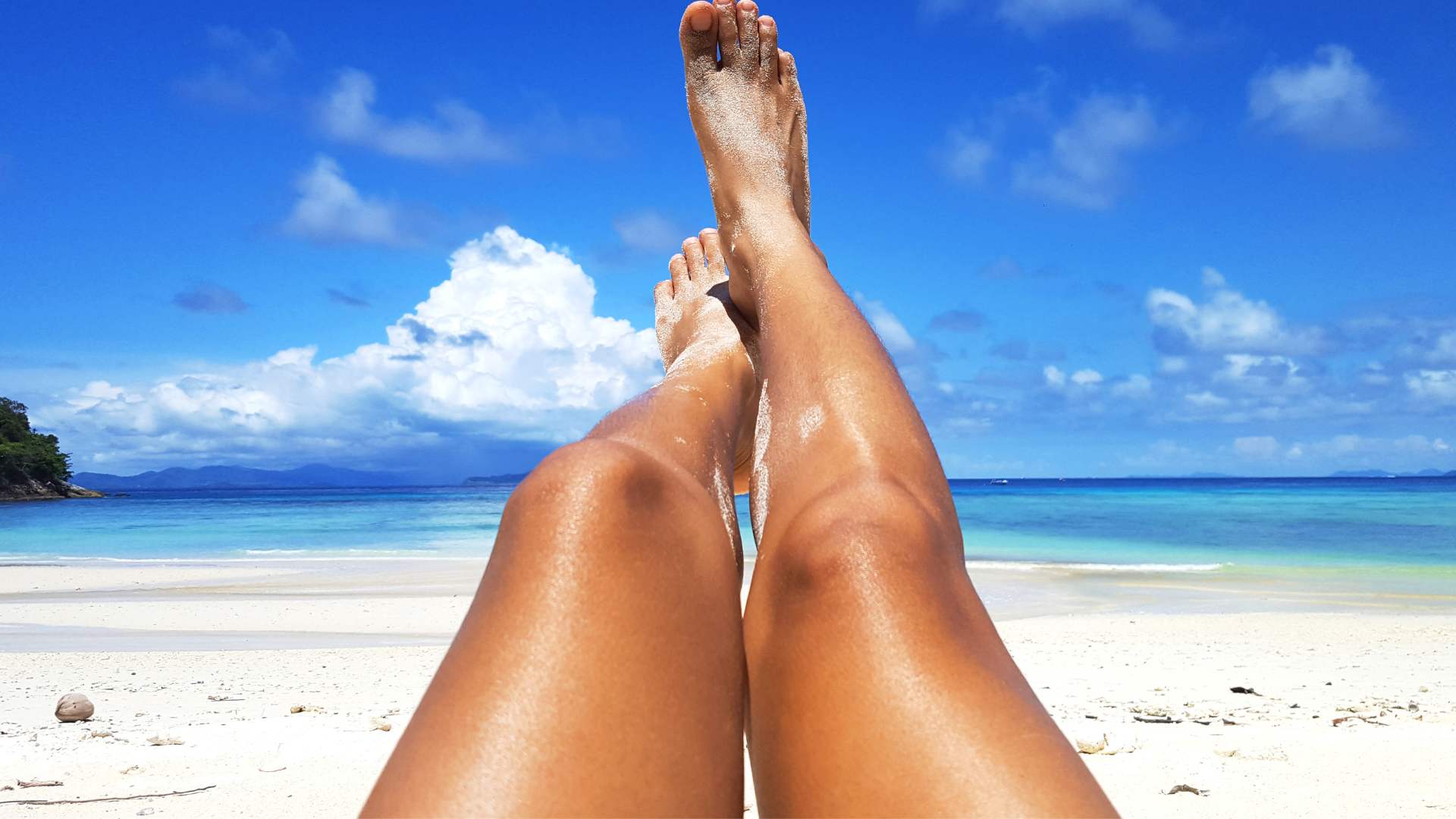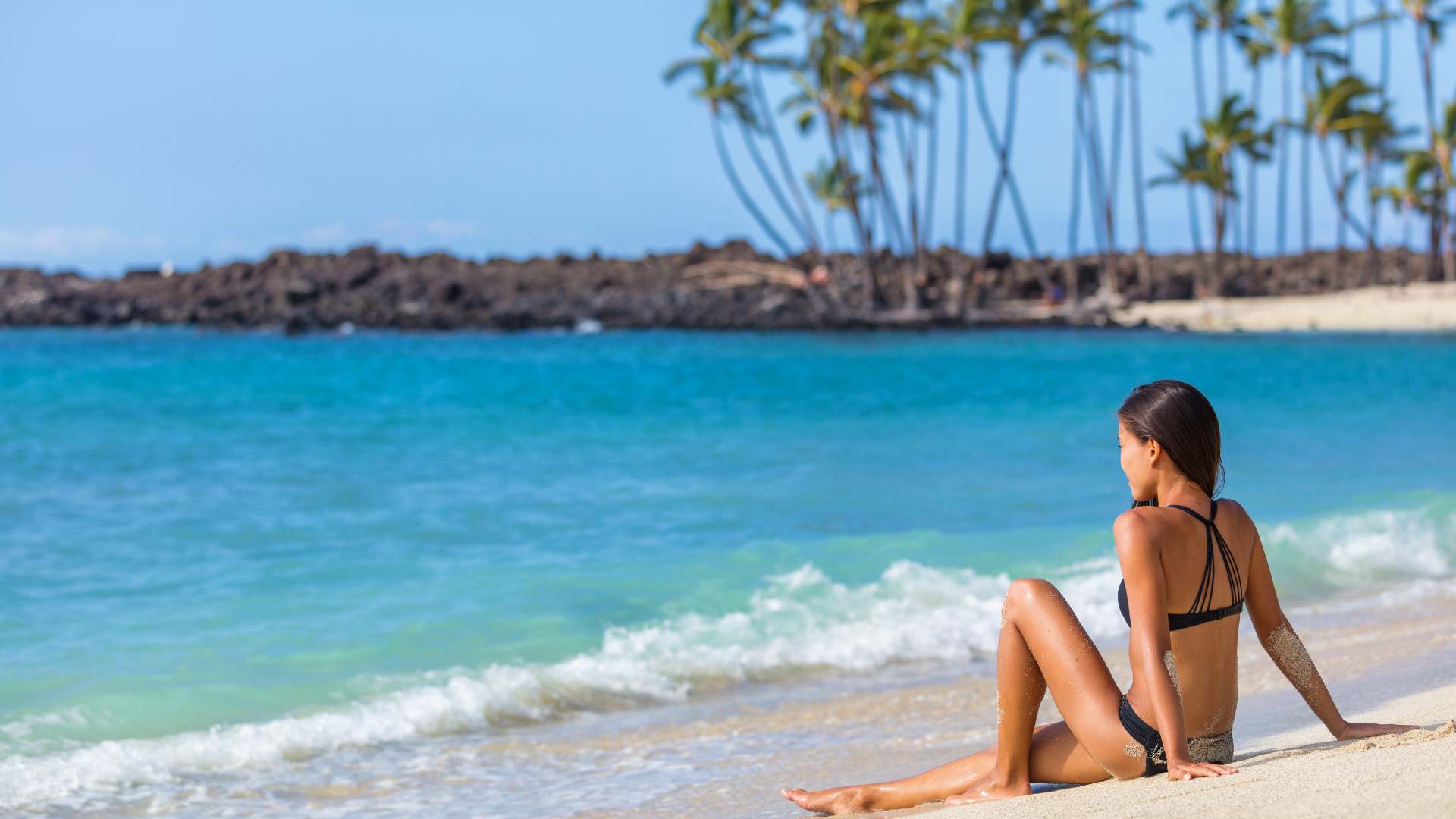
When is the best time to tan?
The best time to tan is when the UV index is low, typically early morning or late afternoon. You'll tan more slowly but more safely during these times.
Quick links:
What are the risks of tanning?
While it takes longer to achieve that golden glow, you'll reduce your risk of sunburn, sun poisoning, and other harmful effects of intense UV radiation.
Always check the UV index in your area to protect yourself from the dangers of ultraviolet radiation.
When is the best time to tan in the morning?
The best time to tan in the morning is between 8 AM and 10 AM. During these hours, the sun is getting stronger but hasn’t reached peak intensity. The sun's rays strengthen slowly during this time, and your skin gets UV exposure more gently.
Early morning tanning has several benefits:
- Lower risk of sunburn than at midday
- Cooler temperatures
- Less crowded beaches and outdoor areas
- Great day starter for early risers
When is the best time to tan during midday?
Midday is actually not the best time to tan. The sun is strongest between 10 AM and 4 PM, with the most intense rays occurring around solar noon. During these hours:
- UV radiation is at its peak
- Risk of sunburn and skin damage is the highest
- Heat can be uncomfortable and potentially dangerous
For safer tanning, it's best to avoid these midday hours entirely. Instead, opt for early morning (before 10 AM) or late afternoon (after 4 PM) when UV intensity is lower. If you must be out during midday, seek shade, wear protective clothing, and use a high-SPF sunscreen.
When is the best time to tan in the afternoon?
The best time to tan in the afternoon is between 4 PM and 6 PM. During these hours, the sun's intensity decreases, but there's still enough UV light for tanning. The sun sits lower in the sky, which reduces direct UV exposure.
Late afternoon tanning offers several benefits:
- Lower risk of sunburn than midday
- More comfortable temperatures
- Gentler on sensitive skin
- Great end-of-day stress relief
Safe tanning practices
Tanning doesn't have to lead to skin damage. With the right approach, you can get a sun-kissed look while keeping your skin healthy. Here's how to tan smarter:
- Use broad-spectrum sunscreen: apply SPF 30 or higher 15–30 minutes before sun exposure
- Limit your time: start with short sessions and gradually increase
- Wear UPF swimwear: while on the beach, use sun-protective swimwear with UPF 50+
- Wear sunglasses with UV protection: protect your eyes from UV damage
- Stay hydrated: drink plenty of water before, during, and after tanning
- Cover up: use wide-brimmed hats and light clothing to shield sensitive areas
- Avoid peak hours: tan before 10 AM or after 4 PM when possible
- Check medications: some drugs (including antibiotics, nonsteroidal anti-inflammatory drugs, and diuretics) increase sun sensitivity
- Moisturize: keep skin hydrated to maintain your tan
- Know your skin type: adjust your tanning routine based on how easily you burn
- Seek shade: take breaks from direct sunlight to cool down
Tanning risks
Excessive UV exposes you to some pretty serious risks.
- Skin cancer: prolonged sun exposure increases your risk of skin cancer. This includes melanoma, the most dangerous type.
- Premature skin aging: UV rays break down collagen, causing wrinkles and age spots. Premature aging makes you look older than you are.
- Skin damage: sunburn is an immediate sign of skin damage. Over time, this can lead to dry skin, dark spots, and sun poisoning.
- Eye damage: UV rays can harm your eyes and cause cataracts or macular degeneration.
- Weakened immune system: excessive tanning might suppress your immune system.
- Heat exhaustion: prolonged sun exposure causes dehydration and heat-related illnesses.
These risks apply to both outdoor tanning and indoor tanning beds. While a tan might look good, the long-term risks are significant. Always prioritize protection while in the sun.
Can you tan at 7 p.m.?
You can tan at 7 p.m. if you still have sunlight then. Here are the pros and cons:
|
Pros |
Cons |
|
Lower risk of sunburn |
Slower tanning process |
|
Cooler temperatures |
Less effective in building melanin |
|
More comfortable experience |
Might not work well in areas with early sunsets |
|
Gentler on sensitive skin |
Limited effectiveness outside of summer months |
If you choose to tan at 7 pm, you'll need longer exposure times to see results.

How long does it take to get a tan?
How long it takes to tan in the sun is different from person to person and depends on a bunch of things. Some factors are about you, others are about where you're trying to tan. To figure out how long it might take you, we need to look at what affects tanning speed.
Here are the main things that matter:
- Skin type: different skin types tan at different rates. Darker skin tans faster and burns less.
- UV exposure: higher levels cause faster tanning but increase the risk of skin damage.
- Time of day: the sun is strongest from 10 a.m. to 4 p.m. Early mornings and late afternoons offer safer tanning conditions.
- Season: summer sun is more intense; winter tanning takes longer.
- Location: UV rays are stronger near the equator and at higher elevations. Reflective surfaces such as water, sand, and snow increase UV exposure.
- Sunscreen: it slows tanning but protects skin. Higher SPF provides more protection. Broad-spectrum sunscreens block both UVA and UVB rays.
Protect yourself with sun-blocking beachwear
When you're not tanning or during high-UV times, stay safe with sunscreen, shelter, and our sun-blocking beachwear. Our selection of UPF 50 swimwear provides exceptional UV protection and makes a stylish fashion statement.
Browse our beachwear by style, type, and coverage level. Some of our popular collections include:
Best time to tan FAQ
How long does a tan last?
A tan typically lasts 7–30 days. For darker skin tones, tans last longer than for those with pale skin. Tan duration depends on skin type, UV intensity, and how you care for your skin. Moisturize and avoid excessive exfoliation to prolong your golden glow.
How long should I tan in the sun?
The time you should tan depends on your skin type and the UV index. For light skin, start with 10–15 minutes. Dark skin can handle 20–30 minutes. Always use sunscreen and increase exposure gradually. Avoid tanning during peak hours (10 a.m.–4 p.m.) to reduce skin damage and cancer risks.
What is the best UV index for tanning?
The best UV index for tanning is between 3 and 5. This range provides enough ultraviolet radiation for tanning without excessive sun damage. Higher UV exposure increases skin cancer risks and premature aging. Always protect your skin with sunscreen, even at lower UV levels.
Can you get a tan with sunscreen on?
You can tan with sunscreen on. Sunscreen doesn't block all UV rays, so your skin still produces melanin. It slows the tanning process but protects your skin from damage. Use a broad-spectrum sunscreen with at least SPF 30 to shield against UVA and UVB rays while developing a safer tan.
Can you tan on a cloudy day?
You can tan on a cloudy day because clouds don't block all UV rays. Up to 80% of the sun's ultraviolet radiation can penetrate light cloud cover. You might not feel the heat, but your skin still receives UV exposure.
What are alternatives for tanning?
Alternatives to sun tanning include self-tanning lotions, spray tans, and tanning pills. Self-tanning lotions contain dihydroxyacetone (DHA), which reacts with skin cells to darken them. Spray tans involve applying a mist of DHA for an even tan. Some people use tanning accelerators or melanin-enhancing supplements. These methods don't require exposure to UV radiation, so they reduce skin damage risks.
How does natural sunlight affect vitamin D levels?
Natural sunlight helps your body produce vitamin D. UVB rays from the sun convert a chemical in your skin to vitamin D3. The amount of vitamin D you produce depends on skin color, time of day, and season. People with white skin make vitamin D faster than those with darker skin.
What are the long-term effects of UV rays on skin cells?
Long-term exposure to UV rays damages skin cells and accelerates aging. UV radiation breaks down collagen and elastin, causing wrinkles and sagging skin. It also mutates the DNA in skin cells, increasing skin cancer risks.
Over time, UV exposure results in age spots, uneven skin tone, and a leathery texture. These effects accumulate with each instance of excessive sun exposure.
How does tanned skin protect against further UV damage?
Tanned skin offers minimal protection against UV damage. When exposed to ultraviolet radiation, your skin produces melanin as a defense mechanism. This darkens your skin and provides an SPF of about 2–4. This minimal protection doesn't significantly reduce the harmful effects of UV rays. Regular use of broad-spectrum sunscreen remains important for all skin types.
Further reading
What are the symptoms of sun poisoning?



Leave a comment
This site is protected by hCaptcha and the hCaptcha Privacy Policy and Terms of Service apply.